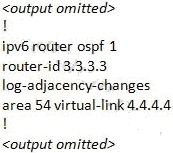LAB
Acme is a small export company that has an existing enterprise network that is running IPv6 OSPFv3. Currently OSPF is configured on all routers. However, R4’s loopback address (FEC0:4:4) cannot be seen in R1’s IPv6 routing table. You are tasked with identifying the cause of this fault and implementing the needed corrective actions that uses OSPF features and does no change the current area assignments. You will know that you have corrected the fault when R4’s loopback address (FEC0:4:4) can ping from R1 to R4 loopback address.
Special Note: To gain the maximum number of points you must remove all incorrect or unneeded configuration statements related to this issue.
Answer and Explanation:
To troubleshoot the problem, first issue the show running-config on all of 4 routers. Pay more attention to the outputs of routers R2 and R3
The output of the “show running-config” command of R2:The output of the “show running-config” command of R3:
We knew that all areas in an Open Shortest Path First (OSPF) autonomous system must be physically connected to the backbone area (Area 0). In some cases, where this is not possible,we can use a virtual link to connect to the backbone through a non-backbone area. The area through which you configure the virtual link is known as a transit area. In this case, the area 11 will become the transit area. Therefore, routers R2 and R3 must be configured with the area <area id> virtual-link <neighbor router-id>command. + Configure virtual link on R2 (from the first output above, we learned that the OSPF process ID of R2 is 1):
R2>enable
R2#configure terminal
R2(config)#ipv6 router ospf 1
R2(config-rtr)#area 11 virtual-link 3.3.3.3Save the configuration:
R2(config-rtr)#end
R2#copy running-config startup-config(Notice that we have to use neighbor router-id 3.3.3.3, not R2’s router-id 2.2.2.2) + Configure virtual link on R3 (from the second output above, we learned that the OSPF process ID of R3 is 1 and we have to disable the wrong configuration of “area 54 virtual-link 4.4.4.4”):
R3>enable
R3#configure terminal
R3(config)#ipv6 router ospf 1
R3(config-rtr)#no area 54 virtual-link 4.4.4.4
R3(config-rtr)#area 11 virtual-link 2.2.2.2Save the configuration:
R3(config-rtr)#end
R3#copy running-config startup-configYou should check the configuration of R4, too.
R4(config)#ipv6 router ospf 1
R4(config-router)#no area 54 virtual-link 3.3.3.3
R4(config-router)#endAfter finishing the configuration don’t forget to ping between R1 and R4 to make sure they work well!
Note: If you want to check the routing information, use the show ipv6 route command ,not “show ip route”.




